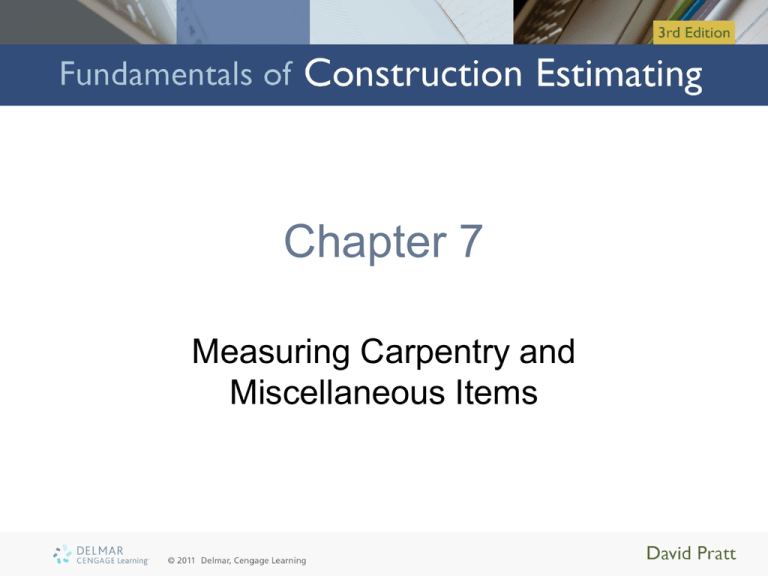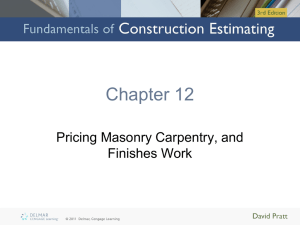Chapter 7: Measuring Carpentry and Misc. Items
advertisement

Chapter 7 Measuring Carpentry and Miscellaneous Items Objectives • Upon completion of this chapter, you will be able to: – Describe a system that will allow an estimator to accurately measure detailed carpentry work on a large project – Calculate quantities of lumber and sheet materials Objectives (cont’d.) – Describe how to measure carpentry work in a takeoff – Describe how carpentry work is classified in a takeoff – Measure rough carpentry, finish carpentry, and miscellaneous items from drawings and specifications – Complete a manual takeoff of carpentry work and miscellaneous items Measuring Rough Carpentry • Detailed carpentry work quantity takeoff – Requires comprehensive carpentry knowledge when estimating • Standard practices and code requirements • Framing methods and design requirements – Estimating commercial and institutional buildings • Different skills required Board Measure • Unit of measurement of lumber Figure 7.1 Sample Board Measure Calculations (Delmar/Cengage Learning) Metric Units • Metric system: – Lumber will be in millimeters – Sheathing does not change • Described in mm rather than inches – Takeoff process • Items of lumber: measured in linear meters Measuring Notes—Rough Carpentry • Generally: – Lumber • Measured in board measure or linear meters – Measure lumber separately • Dimensions, dressing, grade, and species – Describe special treatment required • Kiln dried, pressure treated, etc. Measuring Notes—Rough Carpentry (cont’d.) – Wall boards • Measured in square feet or square meters – Do not deduct for openings • Less than 40 square feet – Classify wall boards • Measure separately – Framing work • Lumber is classified and measured separately Measuring Notes—Rough Carpentry (cont’d.) • Other considerations: – Trusses, truss joists, and truss rafters – Manufactured beams, joists, and rafters – Sheathing – Copings, cant strips, fascias – Soffits – Sidings Measuring Notes—Rough Carpentry (cont’d.) – Vapor barriers and air barriers – Underlay and subfloors – Blocking and furring – Rough hardware Measuring Finish Carpentry and Millwork • Finish carpentry on commercial project – Materials • Supplied by a millwork subcontractor • Installed by general contractor – Architectural woodwork • Supplied by millwork contractor as finish carpentry • Supplied and installed by custom subcontractor Measuring Finish Carpentry and Millwork (cont’d.) • Estimators should be familiar with: – Trade scope definitions of finish carpentry – Architectural woodwork in project location • Evaluate supplied items – Items outside scope of subtrades • All are priced for installation costs and supply Measuring Notes—Finish Carpentry • Generally: – Classify and measure items separately – Rough carpentry: grounds, rough bucks, etc. – Include allowance for rough hardware – Metalwork: measured under miscellaneous metals – Glazing: include in glazing section • Unless integral part of prefabricated cabinet work Measuring Notes—Finish Carpentry (cont’d.) • Other considerations: – Trim – Shelving – Stairs – Cabinets, counters, and cupboards – Paneling Doors and Frames • Usually obtained from subcontractors – Quote prices and deliver goods • General contractors – Estimate cost of handling and installing • Different sections of specifications – Deal with metal and wood doors, frames, assemblies, and special doors Windows • General contractors – Obtains prices from subtrades – No work for them to measure • Small jobs – May not be worthwhile hiring separate specialists • Components may be obtained directly from suppliers Miscellaneous Metals • Miscellaneous metals trade – Prices received from specialized subcontractors • Supply and installation • “Supply only” – General contractor • Ability to prepare a realistic estimate – Wide scope Specialties • Specialty trades – Wide-ranging trade section – Subcontractors will offer different price quotes – Example: bathroom accessories Finish Hardware • Supply cost – Cash allowance is often specified on larger projects • Otherwise obtained from a subcontractor • Estimating costs – Calls for quantity takeoff of all finish hardware requirements Measuring Exterior and Interior Finishes • General contractor’s estimator – Does not usually measure finishing work for an estimate • Almost invariably subcontracted these days • Performed on some occasions Examples • Carpentry and miscellaneous work takeoff—house example – Takeoff notes shown as Figure 7.2a • • • • Rough Carpentry—Floor System Rough Carpentry—Wall System Rough Carpentry—Roof System Finish Carpentry Examples (cont’d.) • Exterior and interior finishes takeoff— house example – Takeoff shown as Figures 7.3 and 7.4 • Exterior finishes • Interior finishes Summary • Thorough knowledge of carpentry construction – Required to prepare a detailed estimate • Estimator must apply a systematic approach • Carpentry requirements of commercial and institutional projects – Usually well detailed











